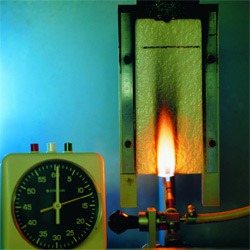PU insulation systems exceed the fire safety regulations and insurance requirements for a wide range of applications.
Following the European classification system, building materials are divided into 7 Euroclasses:
- A1 and A2 for inorganic, non combustible materials
- B, C, D, E, for combustible materials
- F, for materials where performance has not been determined
- Polyurethane rigid insulation reaches a classification from B to E in reaction to fire, depending on a number of factors such as formulation and type of facings
- Additional classifications are used as an indication of the smoke production for building materials: s1, s2 and s3 where in the case of s3 there is no restriction on the smoke production
- Polyurethane rigid insulation reaches a classification from s1 to s3 for smoke development, also depending on the formulation, the type of facings, etc.
- Additional classifications are for burning droplets/particles for building materials: d0, d1 and d2
- Polyurethane rigid insulation is a thermoset, which means that it does not melt under the effects of fire. It does not produce droplets. It is therefore always classified d0
Continuous glowing
Continuous glowing combustion is a self-propagating combustion process without flaming that may occur inside certain porous materials such as fibrous insulation products and fibre boards. In this situation, heat build-up occurs internally due to the continuing exothermic processes initiated by the original exposure to an ignition source. This heat build-up may cease with time if the insulation allows the excessive heat to escape. If not, the process continues with the temperature continuing to rise within the product, eventually leading to ignition.
Insulation products are usually installed behind interior room linings and in cavities behind large surface areas. Continuous glowing combustion fires occurring within the insulation develop slowly and therefore pose a risk because they might remain undetected behind the lining product for a long period of time (up to several hours). Thus these products can act as a possible ignition source over a large-area for adjacent materials resulting in a developing fire.
Polyurethane rigid insulation does not initiate continuous glowing; therefore it does not propagate fire.

For more detailed information about fire safety in buildings see the PU Europe fire handbook:
